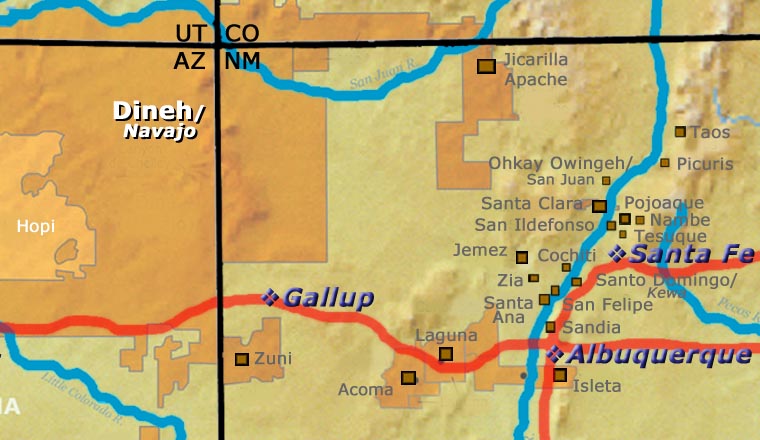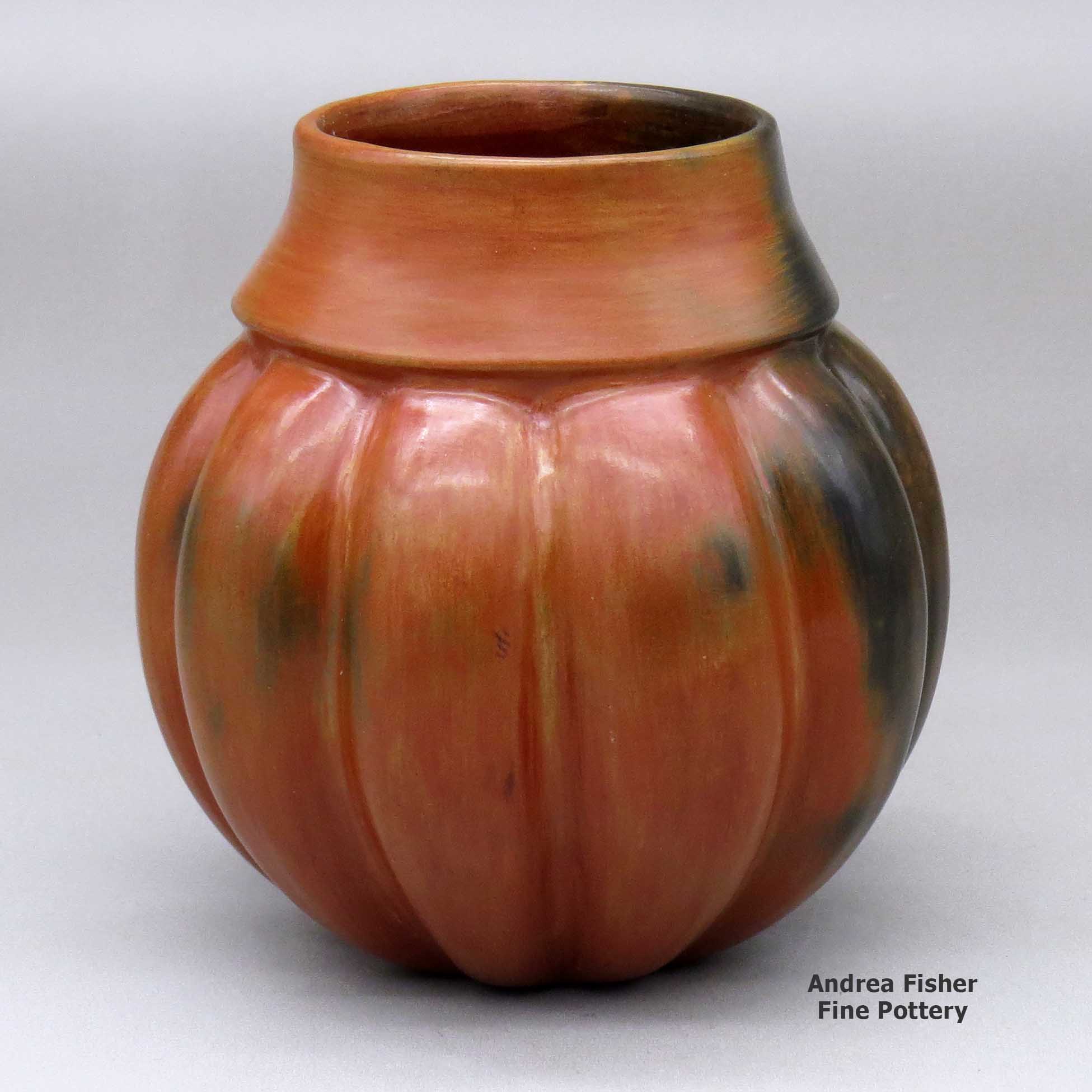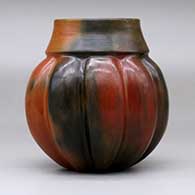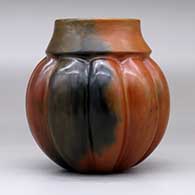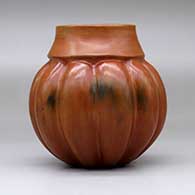
Samuel Manymules
Dineh (Navajo)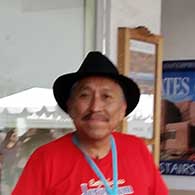
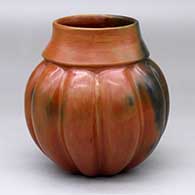
Samuel Manymules was born into the Bitterwater Clan of the Red Horse Nakai Diné Clan in August, 1963. For many years Samuel did what he needed to get along. Jobs that still stick out in his mind were jewelry making, driving a tow truck and working at an auto dealership trying to make ends meet. He'd grown up the Navajo way: working cornfields and tending flocks. Then he started finding potsherds on the ground in the area around where he lived and worked. They intrigued him enough that he taught himself how to make pottery the traditional way. He says he got his inspiration in the early days by looking at the pottery of Christine McHorse and Joseph Lonewolf. After ten years of dabbling with clay, he perfected a thin wall version of Dineh pottery and with his typical high fire practice, he's since elevated Dineh pottery to a whole new level.
Samuel has a long list of accomplishments and awards in the pottery world, the basics of the list cover most of a printed page as he has earned many prominent awards from some of the most distinguished juried competitions in the southwestern United States.
Samuel tells us he builds his pots in his mind before he ever puts his hands in the clay. "I spend most of my days envisioning the shapes, planning how to make a vision a reality, and imagining how the completed pot will look," he says. In keeping with Dineh tradition, Samuel neither paints nor carves his pieces. He knows his clay so well he pushes and presses it into the forms he wants, creating the architectural angles of a master and decorating without actually decorating: he leaves the making of color variations to the firing process where he says the Hand of the Creator makes its mark.
Pieces of Samuel's work can be found at the Denver Art Museum, the Museum of Man in San Diego, Harvard's Peabody-Essex Museum in Salem, MA, the School for Advanced Research in Santa Fe, NM, the Arizona State Museum in Tucson, AZ, and at other institutions.
Some of the Awards Samuel has Earned
- 2002 - Best in Pottery, Heard Museum Indian Art Fair & Market
- 2003 - Judge's Choice ribbons from Susan Folwell and David McFadden, Heard Museum Indian Art Fair & Market
- 2003 - Best of Utilitarian Vessels and two Second Place ribbons, Santa Fe Indian Market
- 2004 - Best of Pottery, Heard Musem Indian Art Fair & Market
- 2004 - One Second Place and two Third Place ribbons, Santa Fe Indian Market
- 2005 - Ribbon of Recognition, Heard Museum Indian Art Fair & Market
- 2005 - Best of Melon Forms, two First Place ribbons and one Third Place ribbon, Santa Fe Indian Market
- 2005 - Best of Pottery, Southwest Museum Indian Marketplace, Los Angeles
- 2006 - Best of Melon Forms, Heard Museum Indian Art & Market
- 2006 - First Place ribbon, Santa Fe Indian Market
- 2006 - Best of Pottery, Southwest Museum Indian Marketplace, Los Angeles
- 2007 - Second Place, Unpainted Traditional Pottery, Heard Museum Indian Art Fair & Market
- 2007 - First Place and Second Place ribbons, Santa Fe Indian Market
- 2008 - Best of Pottery and a Second Place ribbon, Museum of Northern Arizona Navajo Show
- 2008 - Judges Choice Award and Second Place ribbon, Heard Museum Indian Art Fair & Market
- 2008 - First Place ribbon, Santa Fe Indian Market
- 2008 - Best of Unpainted Traditional Pottery, Heard Museum Indian Art Fair & Market
- 2009 - Bill Beaver Memorial Award and Best of Pottery, Musem of Northern Arizona
- 2009 - First Place ribbon for Unpainted Traditional Pottery, Santa Fe Indian Market
- 2010 - Best of Division and a First Place ribbon, Santa Fe Indian Market
- 2012 - First Place and Second Place, Traditional Unpainted Pottery, Pitch finish, any form, Santa Fe Indian Market
- 2013 - First Place, Pottery Division B: Traditional Pottery, Heard Museum Indian Art Fair & Market
- 2013 - Best in Category, First Place and Second Place, Traditional Unpainted Pottery, Pitch finish, any form, Santa Fe Indian Market
- 2019 - Second Place, Traditional Unpainted Pottery, Pitch finish, any form, Santa Fe Indian Market
- 2024 - Category 501: Pitch finish, any form: First Place and Honorable Mention, Santa Fe Indian Market
100 West San Francisco Street, Santa Fe, New Mexico 87501
(505) 986-1234 - www.andreafisherpottery.com - All Rights Reserved

Dineh
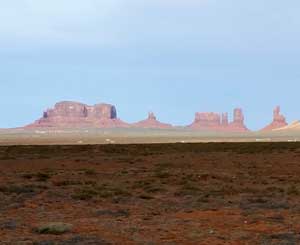
A view in Monument Valley
The Dineh refers to themselves as "Dineh" because the word means "the People" in their language. "Navajo" is a name that was given to them by the early Spanish. Historical and archaeological evidence points to the Dineh people entering the Southwest around 1400 CE. Their oral history still contains stories of that migration as the journey began in eastern Alaska and northwestern Canada centuries after their ancestors made the journey across the Bering Land Bridge from central Asia about 10,000 years ago. They were primarily hunter-gatherers until they came into contact with the Pueblo peoples and learned the basics of survival in this drier climate. Dineh oral history points to a long relationship between the Dineh and the Puebloans as they learned from and traded with each other.
When the Spanish first arrived, the Dineh occupied much of the area between the San Francisco Peaks (in Arizona), Hesperus Mountain and Blanca Peak (in Colorado) and Mount Taylor (in New Mexico). Spanish records indicate they traded bison meat, hides and stone to the Puebloans in exchange for maize and woven cotton goods. It was the Spanish who brought sheep to the New World and the Dineh took to sheep-herding quickly with sheep becoming a form of currency and sign of wealth.
When the Americans arrived in 1846, things began to change. The first fifteen years were marked by broken treaties and increasing raids and animosities on both sides. Finally, Brigadier General James H. Carleton ordered Colonel Kit Carson to round up the Dineh and transport them to Bosque Redondo in eastern New Mexico for internment. Carson succeeded only by engaging in a scorched earth campaign in which his troops swept through Dineh country killing anyone carrying a weapon and destroying any crops, livestock and dwellings they found. Facing starvation and death, the last band of Dineh surrendered at Canyon de Chelly.
Carson's campaign then led straight into "the Long Walk" to Bosque Redondo, a 300-mile trek during which at least 10% of the people died along the way. At Bosque Redondo they discovered the government had not allocated an adequate supply of water, livestock, provisions or firewood to support the 4,000-5,000 people interned there. The Army also did little to protect them from raids by other tribes or by Anglo citizens. The failure was such that the Federal government and the Dineh negotiated a treaty that allowed the people to return to a reservation that was only a shadow of their former territory little more than a couple years after they had left. However, succeeding years have seen additions to the reservation until today it is the largest Native American Reservation in the 48 contiguous states.
Large deposits of uranium were discovered on the Navajo Nation after World War II but the mining that followed ignored basic environmental protection for the workers, waterways and land. The Dineh have made claims of high rates of cancer and lung disease from the environmental contamination but the Federal government has yet to offer comprehensive compensation.
As a semi-nomadic tribe, the Dineh never made much pottery, preferring to use baskets for most storage purposes. They did produce a small amount of pottery for ceremonial uses. Once they were settled on a reservation, pottery began to make more sense. From a beginning making simple wares for colonial estates they transformed their pottery into art. After 1950 Cow Springs brownware began to appear on the market. A trader named Bill Beaver was in Shonto back then, encouraging local potters to "make something different" and the market in the outside world responded positively to those different creations.
Rose Williams is considered the matriarch of modern Dineh pottery. She learned from Grace Barlow (her aunt) and passed her knowledge and experience on to her daughters and many others. Today, most Dineh pottery is heavy, thick-walled and coated with pine pitch (a sealer they also use on many of their baskets). Most Dineh pottery has little in the way of decoration but many pieces have a biyo' (a traditional decorative fillet) around the rim. Unlike Puebloan potters, Dineh potters do not grind up old pot sherds and use them for temper in creating new pottery. Their religion says those pot sherds are infused with the spirits of their ancestors and that forbids the reuse of the material. Similarly, Dineh religion limits Dineh potters to using primarily Dineh carpet designs in the decoration of their pots.
Dineh potters have also created a panoply of folk art, including unfired clay creations called "mud toys." Other Dineh potters, like Christine McHorse, have graduated into the mainstream of American Ceramic Art and easily compete among the finest ceramic artists on Earth.
100 West San Francisco Street, Santa Fe, New Mexico 87501
(505) 986-1234 - www.andreafisherpottery.com - All Rights Reserved

Dineh
$ 1200
zznv4h192
A brown melon jar with ten repousse ribs and fire clouds
5 in L by 5 in W by 5.25 in H
Condition: Excellent
Signature: SM Dine
Date Created: 2024
100 West San Francisco Street, Santa Fe, New Mexico 87501
(505) 986-1234 - www.andreafisherpottery.com - All Rights Reserved
